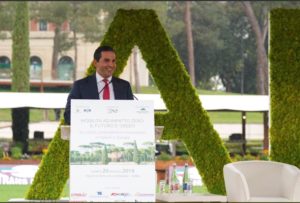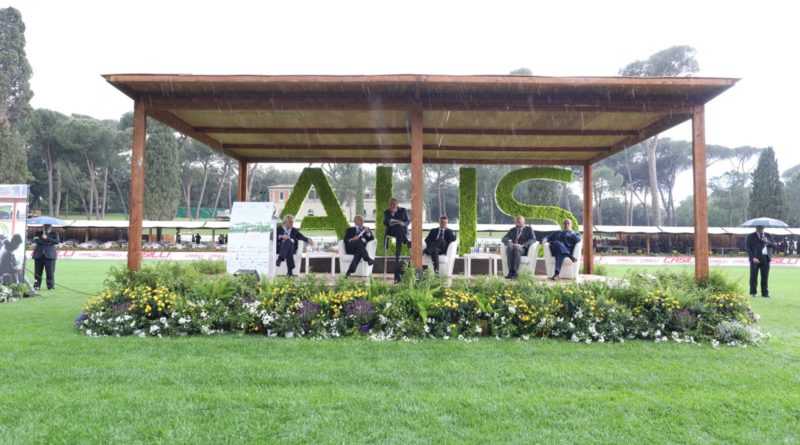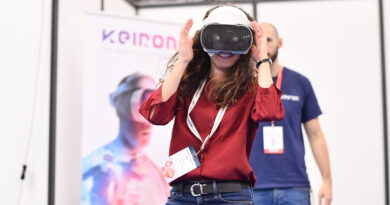The pre-opening of the equestrian competition in Piazza di Siena under the banner of green: ALIS presented in Rome its sustainable intermodal transport
Environmental sustainability is a strategic priority for developed countries, so the 2019 edition of the Rome CSIO 5* presented on May the 20th one of the Italian growing business realities, ALIS, conceived by the Grimaldis, known for their ferries and for their passion for horses, since the brothers Eugenio and Guido are both expert horse riders.
ALIS means Sustainable Intermodality Logistics Association, a network of enterpreneurs, which was created in Rome at the end of 2016 and counts today more than 1,400 member companies, over 152,000 workforce units, a fleet of over 106,000 vehicles with more than 140,500 annual maritime connections and more than 125 Motorways of the Sea, and 22 billion euros of aggregate revenues.
The main objectives of ALIS are safety, environmental sustainability, and technological innovation. The development of ALIS’s ambitious green economy program includes:
– the reduction of CO2 emissions, in order to combat air pollution in Italy and Europe, with a focus on consumption and the adoption of new technologies with zero impact for transport by ship;
– internationalization of the sea transport understood as a process of relaunching Italian companies in export and international markets;
– territorial continuity with Sardinia and Sicily, through the introduction of the Spanish model for the allocation of public grants. In the context of Spain’s highly decentralized administrative structure, the environment and transport, local units have typically operated as growth machines in competition with each other. Indeed, local governments have become boosters of their localities, the main advertisers of the benefits, for both the local comunities and the investors, flowing from disproportionate or poorly planned growth. From this perspective, ALIS applies reduced fares for Sardinia and Sicily residents;
– the development of the South, through the reduction of the economic gap between North and South of Italy, which can only be achieved by reducing the costs of logistics and transport, in order not to further increase the economic and social gap between North and South.
The event in Piazza di Siena opened with the session FOCUS Line: Sustainable Mobility, from which emerged the need to overcome the critical issues related to the protection of natural resources and the sea.
With over 7,400 kilometers of coastline, Italy is, in fact, a real logistics platform on the Mediterranean Sea, with infinite potential in terms of intermodality. Thanks to the 2001 Transport White Paper- European transport policy for 2010, the European Commission proposed the development of “Motorways of the Sea” as a “real competitive alternative to land transport. This European project has made it possible to reduce CO2 emissions and consequently important advantages in terms of sustainability environmental.
These are the highlights of the speech held by Guido Grimaldi, ALIS President:
Thanks to the engagement of our associated entrepreneurs, 1 million and a half of trucks do not circulate anymore on the Italian highways. Thanks to the use of the intermodality freight transport and the opening of more than 600 km of sea routes, we can remove around 1 million and 200 thousand tons of CO2 in Italy, reducing the incidentally and lowering the health costs tied to the reduction of the pathologies deriving from the pollution.”

ALIS has recently signed with the Ministry of the Environment a memorandum of understanding aimed at pursuing concrete actions for the sustainable intermodality. The Grimaldi family firmly believes that sustainability goes hand in hand with economic and social opportunities, that is why ALIS is a form of innovative associationism, that operates in an area of primary importance for Italy’s economy: in fact, the logistics sector accounts for 14% of GDP, and the port sector for 2.6%, with 160,000 companies and 1 million employees.
The Grimaldis decided to present their outcomes in the stunning location of Piazza di Siena just before the beginning of the international Roman show jumping competition, with the intention to enhance the artistic heritage of Villa Borghese.
The new restoration of the original architecture recalls the concept of bio-architecture, which suits well the concept of the show jumping competition, with a restoration in respect of the original structure.
The new Piazza di Siena has been designed bearing in mind the architectural and naturalistic context of Villa Borghese, with a green project, based on a greater reduction in the number of installations, with low environmental impact. The project was aimed at respecting nature and maintaining the original elements of the square itself, including cypresses and hedges, which outline the oval.
A lot has been done last year, thanks to the use of turfgrass and the restructuring of the areas surrounding the oval, such as steps and railings. CONI (The Italian National Olympic Committee) and FISE (Italian Equestrian Federation) took the opportunity to build a legacy.
The interventions on Villa Borghese have had as a direct consequence the creation of new design opportunities. In 2019 the rebuilding process continues, with the aim of expanding the interventions not only in the areas involved in the equestrian event, but with a legacy that links the event with the socio-cultural context in which the show jumping takes place.
Beyond the sport event, the project is based on the idea of rethinking and enhancing an extraordinary place, which is a heritage and a symbol of Rome.
__________________________________________________________________________________________
Video and photos: courtesy of ALIS.




